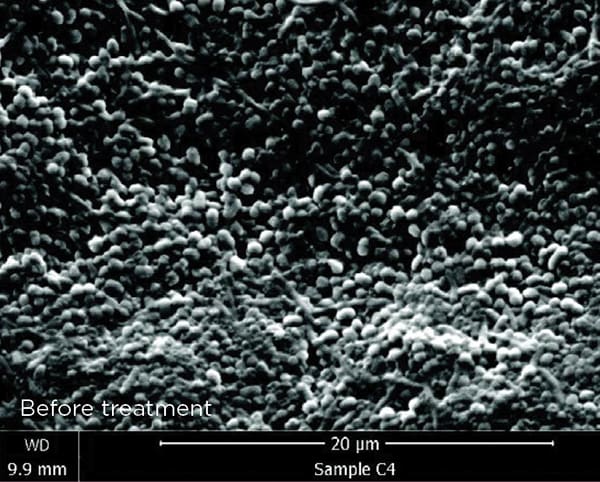Bart Gottenbos, MSc, PhD; Wesley Suntjens, BSc; and Sandra Hötzl, PhD
Objective
The objective of this in vitro study was to quantify the removal of dental biofilm from human enamel surfaces after treatment with the Philips® Sonicare® Power Flosser.
Methodology
Dental biofilms were grown from pooled human saliva on human enamel disks for 4 days, according to an established academic model.* The biofilms (n = 6) were treated with the Philips Sonicare Power Flosser for 3 seconds using the Quad Stream nozzle. To quantify the number of bacteria before treatment, the biofilm volume was measured using optical coherence tomography (OCT) and the bacterial cell density was determined from untreated control samples (n = 6) using confocal laser scanning microscopy (CLSM). After treatment the number of remaining bacteria were counted using CLSM. Additionally, scanning electron microscope (SEM) images were recorded.
Results
While before treatment 0.2-mm thick dense biofilms were present, after treatment only scattered groups of bacteria remained (Figure 1 through Figure 4). Quantitative analysis showed 99.96% removal for the Quad Stream nozzle.
Conclusions
The Philips Sonicare Power Flosser oral irrigator with Quad Stream nozzle removed over 99.9% of the bacteria in this established laboratory model of dental biofilm.
About the Authors
Bart Gottenbos, MSc, PhD
Senior Scientist, Philips Oral Healthcare, Eindhoven, The Netherlands
Wesley Suntjens, BSc
Research Technician, Philips Innovation & Strategy, Eindhoven, The Netherlands
Sandra Hötzl, PhD
Senior Project Manager, Philips Innovation Engineering, Eindhoven, The Netherlands
*Exterkate RA, Crielaard W, Ten Cate JM. Different response to amine fluoride by Streptococcus mutans and polymicrobial biofilms in a novel high-throughput active attachment model. Caries Res. 2010;44(4):372-379.




